eLeapPower: innovator of zero-emission electric vehicles
eLeapPower has developed a suite of trail-blazing technologies for zero-emission electric vehicles. Our innovative powertrain technology optimizes battery performance and significantly cuts charging time. This also allows for bidirectional charging, as well as charging directly from renewable energy sources like wind and solar.
Script of Interview
Interviewee Ms. Caroline Jiang, (CJ)
Position VP, Commercial
Company name eLeapPower
Company website: https://www.eleappower.com/
Interviewer John D. Evans, CFA (JE)
Interview conducted on 26 May 2022
About Caroline Jiang
JE Okay, welcome to the viewers of this latest episode of SEIML Ventures. Today we’re speaking with Ms. Caroline Jiang, the Vice President, Commercial of eLeapPower. As background, eLeapPower has developed a suite of trailblazing technology for zero emission electric vehicles. Their innovative powertrain technology optimizes battery performance and significantly cuts charging time. This also allows for a bi-directional charging, as well as charging directly from renewable energy sources like wind and solar. So, with that as background, welcome, Caroline. Nice to have you here today.
CJ Thank you, John. It’s great honor to be here.
JE Okay, let’s start off by telling the viewers a little bit about yourself. Give them a brief personal overview of yourself and a brief professional review.
CJ Thank you. So, my name is Caroline. Hello, everyone. I am Chinese and born and raised in China. But I will call myself a global citizen because I spent quite a few years in the UK, in Canada and in China as well. So, I have over 15 years of working experience in countries as I mentioned being in China. In China, majority in automotive, in the consumer goods, in the supply chain, and also in strategy. Also in Canada, I was working on automotive, innovation and startup as we’re going to talk further, later. Why, like some brands you might have heard of I served before, for example as the Jaguar Land Rover, Cadillac Fairview, we have the banks like CIBC, TELUS or academic institutions like the University of Toronto, sorry, University of Nottingham. So now I’m working as VP of Commercial at eLeapPower. We are a Canadian, clean tech startup, based in Toronto and China.
JE Okay, so you’ve travelled around a lot and right now you are in China, but what is your sort of home location for business and life? And what is travel as opposed to home location?
CJ Yeah, so in the recent years for most of my life, I stay with my family in Toronto in Canada. But the last year, things at eLeapPower, we expand our business to China. So last year I travelled to China and set up a subsidiary in Shenzhen. So, the business operation is more like a mix, with Toronto and Shenzhen, but I travel back and forth.
JE Okay, very interesting. So, is eLeapPower your only activity or do you have any other outside projects or interests?
CJ Yeah. Thanks for asking that. At eLeapPower, I would call it running a startup, it takes majority of my daytime. And I do I do have a few other roles. For example, I am volunteering on a few associations, because I graduated from Shanghai Jiaotong University. So, I served on a few alumni associations in Toronto and Silicon Valley. I also work with a few incubators globally, I will say, in China and in Canada, serving as more like an advisor and consultant role. In some of my spare time, I also do teaching. So, I do coaching, facilitation on design thinking and innovation. So that’s the level of and the mix of the things that take will take over my weekend and holidays.
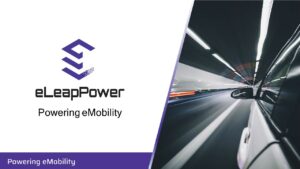
About eLeapPower
JE That sounds like a whole suite of activity. Congratulations. Okay, let’s now turn to the company, eLeapPower. Tell us how eLeapPower came to be and how your association with it came to be?
CJ Thank you. Well, I came across and with eLeapPower in 2018. That was almost four years ago. As I mentioned, I do consulting and advisory to incubators and startups. So back then, eLeapPower, I got in touch with the founder of eLeapPower, Tony Han, and started to help the company to build. Started as a consultant to build the first draft of the business plan, strategy, fundraising plan, and also go-to-market strategy. So, these are the starting points of my relationship with eLeapPower. And it’s been almost four years now.
JE Okay. So, when was the company established, presumably before you joined, and what has been the critical events today, either before you joined or after?
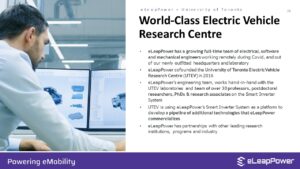
CJ Sure, I can share a little bit about the company. The company was founded in 2016, April 22, which is also the International Earth Day. So, that actually tells us the mission of the company is to, to actually help the planet. So, the company when it was founded by Tony in 2012, it was jointly set up to research, the power line, with the Electric Vehicle Research Centre jointly with the University of Toronto. So, from that joint research team, there are several core patents, innovation patents came out from the research team. And we got our first patent in 2014, which was before the company was actually founded in 2016. And then the a few other milestones, it was the first client, we secured our first automotive client in 2019. And we received our Series A funding, we have the official closing in 2021 of $21 million funding, and then in 2021, later in 2021, we actually set up our subsidiary in China. So, I will say that is very good preparation for the company to start and grow.
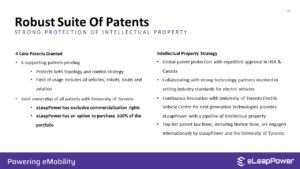
JE Let me just ask a follow up question. Just to diverge for a second, you said the Research Centre for electronic vehicles at University of Toronto. So, I know UofT but they didn’t have a e-vehicle research center back when I went through. So, this is a specialized research center in the university to collaborate with industry for e-vehicle development?
CJ Yeah, correct. Sorry, it’s a commercial aim, I think it might be like recently your academic institutions are collaborating with commercial partners to achieve the commercialization. So, the research and the initial development happens in the university. And the funding came through the government, the University and also the commercial partners. So, it’s a joint funding. And then all the technologies came in, come out from the lab will come from the research team will go to a commercialization stage, and the commercial partner of that whole programme will be responsible for the commercialization.
JE That’s very interesting, because having been in academia, I know the importance of a real integration and partnership between universities and commercial enterprises. So good to see it’s happening. Okay, so you’ve talked about how the company has been funded through today, and you’ve gone through one round $21 million Series A, I think it was the end of last year. So now let’s just turn to describing what precisely your main product or service offering is.
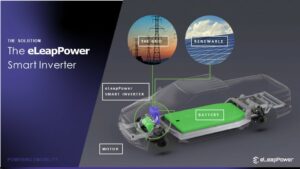
CJ Sure, yeah, I guess. So, as I mentioned in the beginning, we are committed to save the planet. So, accelerating the adoption of electric vehicle is our mission. So how we make it happen? We have two flagship products, the first one is the smart inverter system. So, the scoring model described is a smart inverter, is a power electronics unit that acts like the brain of the electric vehicle. So, it controls the power conversion within the vehicle. Every electric vehicle already has an inverter and what we did is we did an innovation on the topology of the design of the inverter and also we innovate on the on the control algorithm of the whole inverter. So, this achieved like when you introduce the introduce our company you mentioned about that it enables a vehicle to charge faster, to drive further with the same battery size and also makes it cheaper for the manufacturer to produce the vehicle. And one more thing is we all know that autonomous driving is our future. And to enable the autonomous driving charging is one key part of it as well. When we say autonomous driving, I mean autonomous driving vehicle without a driver, there’s no human being who can jump out of the car and plugin to charge. So, we have another set of the product is the wireless charging system. Now they enable the car to charge automatically when the car is driving autonomously on the road.
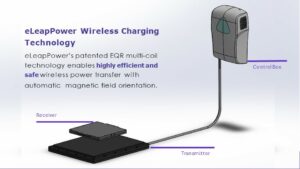
JE Yeah, exactly. Okay, so now let’s turn a little bit more to the commercial side. What is your geographic area in terms of your market, your target clients at this point in time, and what do you see it longer term?
CJ We are a Canadian company headquarter wise. Our commercial launchpad is in China. So, our first client, first paying client, is a Chinese car manufacturer. And then, but we are not saying that China is the only market we focus on global, so North America is our next step. We already started the collaboration with the University of Waterloo on the vehicles from General Motors. And we have another pilot project with the largest logistics company in Canada called Purolator on the logistics vehicles produced by Ford. So, we’re doing these two pilot projects to try to launch our products and systems on the North America vehicles.
JE Okay, so again, sort of a China and Canada focus to start off with, but there are electric vehicles all around the world. So, do you see going to sort of a global marketing plan very soon? Or will China and Canada keep you busy for many years to come?
CJ Yeah, that’s a really, really good question. So, I think as a company of our size, it is very, very relative. Honestly speaking, we are very small, we have a team over 40 people globally, majority of them sit in Canada and we now have a 10 people team in in China now. So, we know that keeping a focus is the key, is a key now at this stage. So, we are focusing on delivering the product for the first couple of first clients and delivery on the first couple of pilot projects. So I was in Europe, North America, South America and also the other parts of Asia. They will also be our target market, but that will be our next step.
JE Okay. Now, I’m not an expert in electric vehicles. So, give me a little bit more background about who are the main buyers of your product, is it only for cars or is it for other types of vehicles as well?
CJ Yeah, the definition of vehicle is actually very broad. So, now we are focusing on cars, because the global EV trend and also the global mission on the carbon reduction. So that, that’s why we are focusing on cars. In cars, we only produce a small component of the vehicle. So, we do not sell directly to the customer. We sell to the car manufacturers. Car manufacturer, they could be OEM, they could be the whole car manufacturers, or the tier one the large car manufacturers, like automotive suppliers, those are our target customers. But our technology can also be applied to like aircraft, ships, boats, and other type of vehicles. But we have not started exploring that yet.
JE So, it’s a focus on automobiles as the first step.
CJ Correct.
JE Okay. So then turning to the sort of the last point of the commercial process: what’s your general revenue model? How do you charge and make money?
CJ Yeah, that is really key question. We are at the pre-revenue stage. So, we do not have revenue at the moment. The above, we are actually very fortunate, we have a commitment from one large car manufacturer in China, which has a potential of producing over 30,000 units. By units I mean smart inverter systems and which can lead us to over millions of revenues in the coming years.
JE Okay, and when will that revenue generation start, do you think?
CJ We are expecting that from next year.
JE Okay, starting 2023 Okay.
CJ So, we are I think on top of that and what I want to say is we are a technology developer. So, we develop the frontier of very advanced technology. So, we collaborate and partner with global experts on manufacturing. So, we come from and partner with the excellent manufacturing partners to produce the smart home router and wireless charging systems.
About the Electric Vehicle (eV) Industry
JE Okay, So, now let’s turn to the industry. I’ve classified eLeapPower in the electric vehicle industry. Is the electric vehicle industry the correct classification of your company, or would you put it into a slightly different or more specific sub sector?
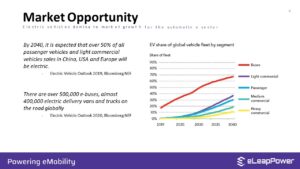
CJ Now, well, we are happy to be included in in the electric vehicle industry. It is broad but every single electric vehicle has an inverter inside. So, the industry size is huge. We are, I want to share a few market data here, according to Canalys, the 2021 the global electric vehicle new car sales has reached 6.5 million units which almost doubled on the year before. So, and also from a data provided by Bloomberg, the whole electric vehicle market will go up to 40 million units in the year 2030. So, we are actually looking at a growing market in the next few decades.
JE Okay. So, then, if that is the correct definition of your industry segment, who then are your direct and major competitors?
CJ There are, how would I say that not so, electric vehicles compared to the previous ICE vehicle, like gas propelled vehicles, it is very young and very new. So, there are a few big players like Tesla, like Volkswagen in this field, but it is not as many firms as my incumbency in the ICE vehicle industry. So, we are actually competing with a large firms and small firms. I would say it’s a global market, global players such as Bosch, such as Magna and also BorgWarner, these large firms, they all produce inverter systems. They are more like a system integrator. And there are well in China my email was the or the Siemens, they’re all in play in the China market. And they are all innovators on this market. There are quite a large number of small companies who are trying to innovate on the powertrain of electric vehicles. So, it still has a lot of a lot of areas that can be innovated and they can be disrupted. So, we’re looking at a huge market, I would say.
JE Just a follow up question to educate me in the market, because you mentioned that there’s small companies, there’s big companies like Tesla. So, Tesla and Volkswagen, I’ve heard a lot about them. Do they build every one of their individual components? Or hypothetically speaking, might you be a supplier to a Tesla or a Volkswagen in the future?
CJ Yeah, we’ll be honored to be a had to be certified as a supplier to either firm. Yeah. So, for Tesla and Volkswagen, no, they don’t produce every component by themselves. I worked for Jaguar Land Rover and I worked on the joint venture programme, joint venture factory setup in China in Changshu, actually, for a couple years, so I’m a little bit familiar with the how we set up the manufacturing. So, on the whole vehicle, there are 1,000s of components. And usually, they are they are coming from like hundreds or 1,000s of suppliers and then the OEM like Tesla and Volkswagen, they are in charge of the vehicle design and control the quality and deliver them to the customer they deal with the customer directly. So, yes, so, we will be. Sorry one more point to add on that is, to ensure the manufacturing and supply to their customers like Tesla and Volkswagen they usually they will have more than one supplier on each component to ensure the supplies in time and, and abundant.
JE Okay, so, just to reminisce about something, I recall when I bought my first 1967 Mustang, as a used one. It was a Ford Mustang, but the spark plugs were built by a different company, the carburetor, a Holley carburetor, was built by a different company, the tires were a different company, maybe the wheel discs were. So, actually, we look at a car and we say oh, it’s a Ford or it’s a Tesla, but actually contains a lot of components directly from other vehicles. So, there is an analogy there even though electric vehicles are very different from internal combustion engine. So, I think I’ve learned a little bit about this.
CJ And also, one more point I want to add is, there are car companies like BYD, they actually are very focused on production as well. So, they produce most of their components from their own group, either their subsidiaries or joint ventures with other partners.
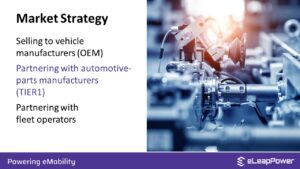
JE Okay, so you say in terms of industry structure, and how eLeapPower is positioning itself, it’s positioning itself as a specialist provider of one component, it’s not thinking that in 10 years, it’s going to be building a whole car by itself.
CJ So far, we don’t have that plan, we are actually targeting to become a solutions provider, that we call ourselves tech innovators on the powertrain. So electric vehicle powertrain systems. So, we want to become, grow into a solution provider on the core technologies of power conversion in the electric vehicle.
JE Okay, fair enough. So, let’s go to the final part of our questions and just sort of looking ahead. So, we’re almost halfway through the 2022. What are the key, what are your key goals before the end of the year comes?
CJ Grow the team, Yeah, grow the team because we just set up our subsidiary in China. So, we are a growing team, we are hiring a lot of engineers in Shenzhen. Our office is in Shenzhen and the growth and moving our products to our next stage and to be more ready for supply and supplier customer in next year. And also, to grow globally as well, to expand the partnership with the other car manufacturers, tier one automotive suppliers and authenticate institutions on the future of our technology development.
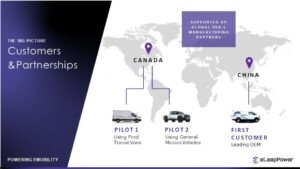
JE Okay, so do you see yourself having an office other than Canada or China in the next year? Or are those two countries going to be the focus for the short term?
CJ I think for now, that will be it. I don’t think we can expand as fast as a consumer goods industry. So yeah. So, where we are with, to serve the first client is a key priority now.
Looking Ahead
JE Okay. Very interesting. Very interesting to hear your thoughts. And so, I’m just going to close off because I know you’ve been in China for quite a while now. Are you going back to Canada shortly? Will you be coming back to China again, and this year? Where will your travels take you for the next six months of this year?
CJ Yeah, so for the next six months or for the last?
JE For the last six months of this year,
CJ Yeah. Travelling back to Canada soon just have a reunion with my family and also spend some time in the summer. The summer in Toronto is very beautiful, so, I don’t want to miss that. And for the business, travelling back and forth, like I mentioned in the very beginning, will become the norm of the business activities.
JE Okay, so you will be one of these long-term, long-distance fliers for the foreseeable future.
CJ Hopefully not too often and without staying in the hotel for too long.
JE Okay. And hopefully quarantines and lockdowns will be a thing of the past by the time we finish this year. Okay.
CJ Yes, fingers crossed. Yeah, I think that they will come soon.
JE So, thank you very much for your time, Caroline, that was interesting. I mean, as you highlighted, electronic vehicles are growing at a very fast pace. So, this is something everybody needs to know about. Even if you don’t get involved with a company and production, you’re probably going to be owning one at some point in time. So, thank you very much, and best of fortune for your company in the near term and the long term.
CJ Thank you so much, John. It’s great to comment and share my experience and stories with the audience and feel free to reach out if there’s any questions I am happy to support.
JE Fair enough.
CJ Thank you.
End.








